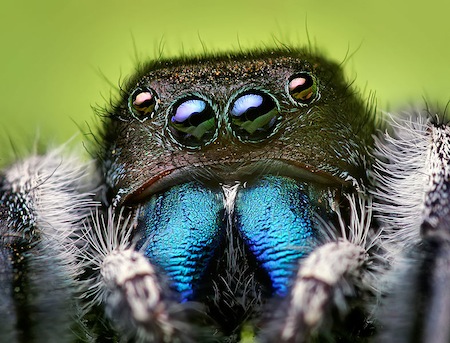 Intelligent Design
Intelligent Design
Spiders Have Eight (Well-Designed) Eyes

Have you ever wanted eyes in the back of your head? Spiders have eight eyes, compared to our two. They can boast of better vision than ours on some counts; sharp, color vision that extends into the ultraviolet. Their ample set of peepers allows for division of labor: the main pair in front helps them see detail, while the smaller eyes wrapped around their heads warn them of looming threats. Stephanie Pappas wrote about spider eyes on Live Science recently.
“We see that division of labor within that visual system… That’s pretty cool if you think about it, because we only have one pair of eyes.”
That was actually a quote from Skye Long, a doctoral student at the University of Massachusetts at Amherst, who decided to test and find out what the extra eyes are for. She outfitted an enclosure for her 46 jumping spider subjects and used paint to “blindfold” the principal eyes on a third of them, and the adjacent, smaller eyes (anterior lateral pair) on another third, leaving one third blindfold-free. (Don’t worry about the spiders; the paint could be easily removed.)
Then she used an iPod Touch to create images of a black dot growing or shrinking in size. When seeing the “looming threat,” the spiders backed up quickly and raised their front legs in defense, as if they felt scared — even when the principal eyes were covered. This means the anterior lateral pair are crucial for alerting the spider to potential dangers. What are the other four eyes used for? That’s what Long wants to find out next.
This would have been a “pretty cool” Halloween animal story, featuring a nice, experimental science project, had not Skye Long wandered off into evolutionary tale-telling:
That means the secondary eyes are crucial for alerting the spider to dangerous motion, Long said. Spider eyes are a “really cool step in evolution,” she added; insects have compound eyes with multiple lenses, and some areas of those eyes have certain functions. Spiders, on the other hand, separate out visual functions across their heads.
“This is a different pathway that evolution has taken to allow a very small animal to have a very extensive visual system,” Long said.
Right. No matter how cool or well-designed the adaption, just say it evolved. It’s a “really cool step in evolution.” It’s a “different pathway evolution has taken.” The blind, aimless, purposeless process of natural selection gave spiders a “very extensive visual system.” Turn in your paper and get an A.
Here’s a better way. Look what researchers at the Optical Society of America are doing with spiders. Incredible as it sounds, they are taking spider silk and using it for fiber optics. Spider silk is already prized as an ideal material: it’s strong, flexible, and biodegradable. Now, a team has found it can also transmit and guide light almost as well as glass fibers.
One team is using it as a light guide in photonic chips, while another is trying to imitate the proteins in silk from spiders and silkworms to be able to manufacture it. This second team has already made a silk-based “plastic” that can be used for everything from biodegradable cups to implantable devices that dissolve in the body. Fiorenzo Omenetto presented his work in a superb TED Talk that raised the audience to their feet without him once mentioning evolution. And he is getting grants from the NSF!
Evolution is a straw scarecrow whenever it appears in biological research. The whole story is intelligent design, in the animals and plants studied, in the experiments devised to gain knowledge about them, and in the applications they lead to. Animal tricks become science’s treats.
Image: adult male Phidippus audax jumping spider/Wikipedia.
